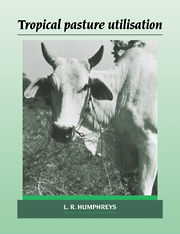Book contents
- Frontmatter
- Contents
- Acknowledgements
- List of abbreviations
- 1 Introduction
- 2 Pastures in tropical farming systems
- 3 Grazing and the environment for pasture growth
- 4 Effects of defoliation on the growth of tropical pastures
- 5 The modification of botanical composition by grazing: plant replacement and interference
- 6 The response of grazing animals to tropical pastures
- 7 Stocking rate and animal production
- 8 Continuity of forage supply: 1. The integration of different pastures
- 9 Continuity of forage supply: 2. Pasture conservation and supplementary feeding
- 10 Systems of rotational, deferred and mixed grazing
- 11 Conclusion
- References
- Index
8 - Continuity of forage supply: 1. The integration of different pastures
Published online by Cambridge University Press: 23 September 2009
- Frontmatter
- Contents
- Acknowledgements
- List of abbreviations
- 1 Introduction
- 2 Pastures in tropical farming systems
- 3 Grazing and the environment for pasture growth
- 4 Effects of defoliation on the growth of tropical pastures
- 5 The modification of botanical composition by grazing: plant replacement and interference
- 6 The response of grazing animals to tropical pastures
- 7 Stocking rate and animal production
- 8 Continuity of forage supply: 1. The integration of different pastures
- 9 Continuity of forage supply: 2. Pasture conservation and supplementary feeding
- 10 Systems of rotational, deferred and mixed grazing
- 11 Conclusion
- References
- Index
Summary
Discontinuities in forage supply are avoided or mitigated by pasture managers in order to (1) minimise animal stress by maintaining body condition and animal survival, (2) promote successful reproductive activity, and (3) sustain growth, milk secretion or the production of fibre. This policy may be directed to meeting a particular market, such as urban demand for fresh milk produced in the dry or cool season, or cattle in high condition at the beginning of the wet season. There may be a special farm demand, such as the need for draught animals to be in working order at the beginning of the ploughing season.
Social pressure may operate on the farmer to avoid seasonal shortfalls in production. The owners of milk or meat processing facilities minimise the costs of machinery installation and maintenance if plants operate continuously or for the greater part of the year, and these considerations also favour continued employment of workers at the plant. It should be recognised that continuity of forage supply is only achieved through added farm costs, and the farm incentive to maintain continuous output depends upon price adjustment for season of milk or beef production, or a premium payable for meat class and quality.
There are five approaches to the maintenance of continuity of forage supply:
The seasonal pattern of animal demand for nutrients may be synchronised with the seasonal availability of forage, by adjusting purchase and sale of animals and time of mating.
[…]
- Type
- Chapter
- Information
- Tropical Pasture Utilisation , pp. 120 - 139Publisher: Cambridge University PressPrint publication year: 1991



